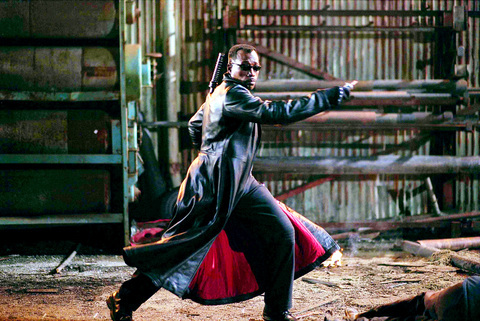Wesley Snipes may have achieved the Hollywood dream of starring in a comic book franchise that doesn't require real acting, but he doesn't seem to appreciate his good fortune in the disjointed, overlong Blade: Trinity, which bills itself as the series finale. (Don't be so sure; at the end the door is left ajar.)
The Blade movies, which have allowed the star to coast for several years on box office insurance, demand only that the 42-year-old actor stay pumped up and ready for kung-fu action.

PHOTO COURTESY OF FOX FILMS
But the only emotion that his character, a glowering half-human half-vampire hunter of the undead, is able to muster in the third installment is a sense of mild irritation at having to go through the hassle.

PHOTO COURTESY OF FOX FILMS
Directed by David Goyer, who wrote the screenplays for the first two chapters, Blade: Trinity is a choppy, forgetful, suspense-free romp that substitutes campy humor for chills. You long for a moment as terrifying as the opening sequence in the first Blade when a vampire invasion turns a rave into a horrifying bloodbath.
Some of the silliest moments belong to a fanged Parker Posey as Danica Talos, a strutting, sneering bloodsucker dressed in black leather who radiates the sadistic glee of a psychotic dominatrix tweaked on crystal meth. The role suits the actress who typically conveys the hysteria of a needy exhibitionist who will trample anyone in her way to grab the spotlight.
Her scenes are matched in tongue-in-cheek drollery by John Michael Higgins' brief turn as Dr Vance, a nerdy psychiatrist assigned to interrogate Blade after he mistakenly kills a human and is captured by the FBI. A vampire ally who poses as a mealy-mouthed shrink, the good doctor pelts Blade with the kind of inane psychobabble that a 1950s psychologist might pose to an 11-year-old bully after a schoolyard fracas.
Blade: Trinity begins in the Syrian desert where Danika and a vampiric cadre tunnel beneath the sand to stir the world's first vampire, who goes by the name of Drake (Dominic Purcell), into action.
Drake's lethal potency far exceeds that of his descendants, whose powers have been diluted by centuries of cross-breeding with humans, and his resuscitation augurs a possible vampire global conquest.
At the same time, Blade is destroying a vampire lair and is caught by the FBI after an extended -- and dull -- car and motorcycle chase. He is rescued from captivity by a "sleeper cell" of so-called Nightstalkers, led by Abigail (Jessica Biel), the cool, resourceful daughter of Blade's mentor, Abraham (an aimless, mumbling Kris Kristofferson).
Abigail's wisecracking sidekick, Hannibal (Ryan Reynolds), is as fearless as he is rash and never at a loss for a cheeky barb, even when menaced. The Nightstalkers are aligned with Sommerfield (Natasha Lyonne), a blind scientist who has figured out how to rid the world of vampires with a biological weapon made from a sample of Drake's blood.
The movie's disjointed action sequences lurch toward an anticlimactic rooftop showdown between Blade and Drake, who in a final demonic flourish shape-shifts from thug to monster. The ultimate dispatching of the bloodsuckers into little sizzles of smoke and melted bone recalls the demise of the Wicked Witch of the West in The Wizard of Oz.
Blade: Trinity has one genuinely creepy moment. In a trip to an out-of-the-way warehouse, the Nightstalkers discover a sinister blood farm where the vampires hold human captives in suspended animation, simultaneously nourishing and draining these unconscious blood donors who are strung up in clear plastic cells. Think The Matrix recycled and done on the cheap, minus the metaphorical gobbledygook.

June 9 to June 15 A photo of two men riding trendy high-wheel Penny-Farthing bicycles past a Qing Dynasty gate aptly captures the essence of Taipei in 1897 — a newly colonized city on the cusp of great change. The Japanese began making significant modifications to the cityscape in 1899, tearing down Qing-era structures, widening boulevards and installing Western-style infrastructure and buildings. The photographer, Minosuke Imamura, only spent a year in Taiwan as a cartographer for the governor-general’s office, but he left behind a treasure trove of 130 images showing life at the onset of Japanese rule, spanning July 1897 to

One of the most important gripes that Taiwanese have about the Democratic Progressive Party (DPP) is that it has failed to deliver concretely on higher wages, housing prices and other bread-and-butter issues. The parallel complaint is that the DPP cares only about glamor issues, such as removing markers of Chinese Nationalist Party (KMT) colonialism by renaming them, or what the KMT codes as “de-Sinification.” Once again, as a critical election looms, the DPP is presenting evidence for that charge. The KMT was quick to jump on the recent proposal of the Ministry of the Interior (MOI) to rename roads that symbolize

On the evening of June 1, Control Yuan Secretary-General Lee Chun-yi (李俊俋) apologized and resigned in disgrace. His crime was instructing his driver to use a Control Yuan vehicle to transport his dog to a pet grooming salon. The Control Yuan is the government branch that investigates, audits and impeaches government officials for, among other things, misuse of government funds, so his misuse of a government vehicle was highly inappropriate. If this story were told to anyone living in the golden era of swaggering gangsters, flashy nouveau riche businessmen, and corrupt “black gold” politics of the 1980s and 1990s, they would have laughed.

In an interview posted online by United Daily News (UDN) on May 26, current Chinese Nationalist Party (KMT) Chairman Eric Chu (朱立倫) was asked about Taichung Mayor Lu Shiow-yen (盧秀燕) replacing him as party chair. Though not yet officially running, by the customs of Taiwan politics, Lu has been signalling she is both running for party chair and to be the party’s 2028 presidential candidate. She told an international media outlet that she was considering a run. She also gave a speech in Keelung on national priorities and foreign affairs. For details, see the May 23 edition of this column,